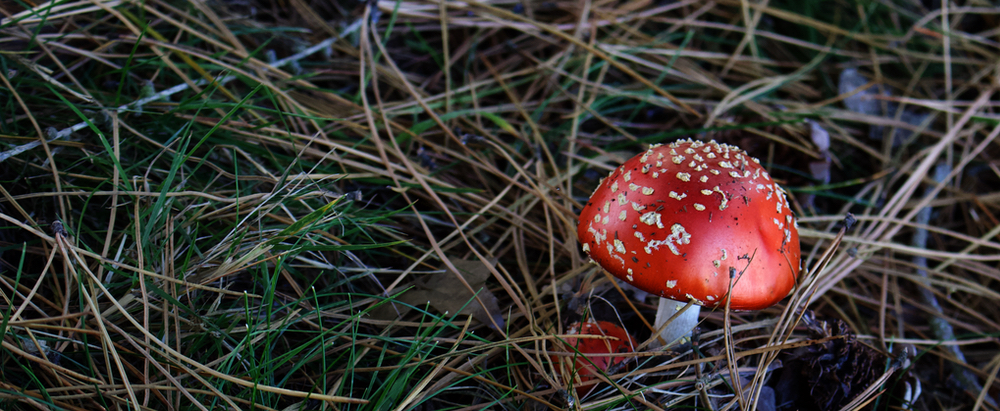
Acid Dyeing Yarn For My Gro Hat Knitting Project
Hello friends,
I was on Instagram about a month ago, and saw a knitted hat on my feed that I immediately fell in love with. The hat was a project based on the Gro Pattern by Fiber Tales. I loved the cabled plant motif, and how nice and toasty it looked like in the pattern photos, so I bought a copy of the pattern.
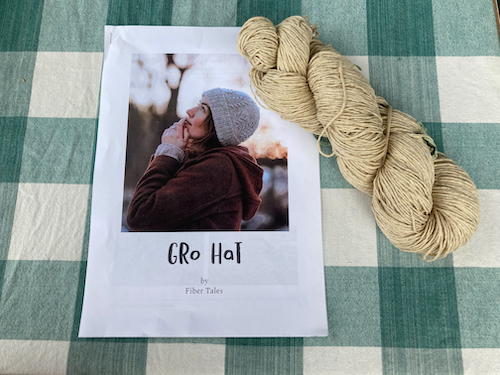
The pattern calls for one 100 gram skein of DK (double knit) yarn, and I knew I had a lot of undyed superwash DK possum/merino yarn (that I got from one of the Woolyarn outlet store sales when I lived in Wellington) in my stash.
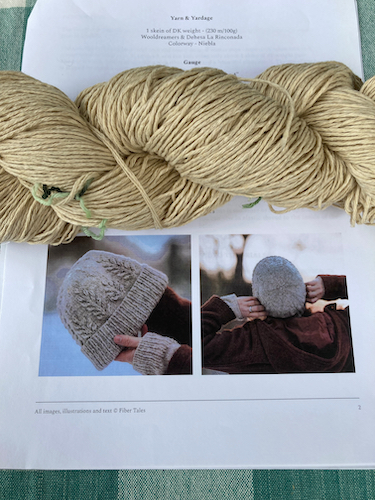
I also knew what colour I wanted to dye the yarn. Back when I was living in Wellington I processed, dyed, spun, and knitted, a huge shawl for a Creative Fibre exhibition called the Southern Skies shawl using raw alpaca fleece a friend on a farm gave me. I had processed and dyed white alpaca fleece in sequential aurora colours based on a photo I had taken of an aurora, spun up each section of yarn, and then knitted the project, adding silver beads to show the constellations of the southern night sky.
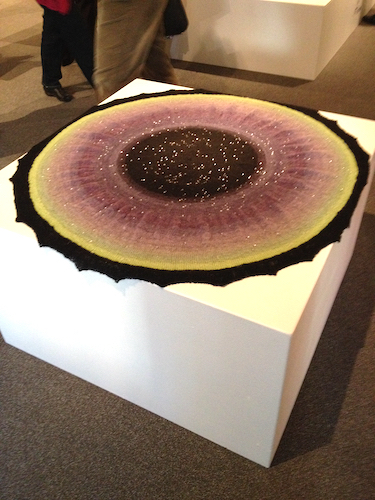
One of the colours in the shawl was a beautiful sage green, called Aurora 4 according to my dyeing notes, and this was the colour I wanted to dye for this hat project.
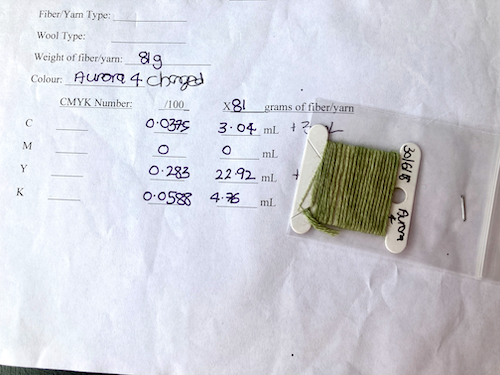
After checking my dyeing project notes I calculated how much dye I would need to add to this project. The total amount of yarn I chose for this project was 123 grams of undyed superwash yarn. I used more yarn than the pattern suggested, because it is good to have extra for swatching, and also to not have to play yarn chicken.
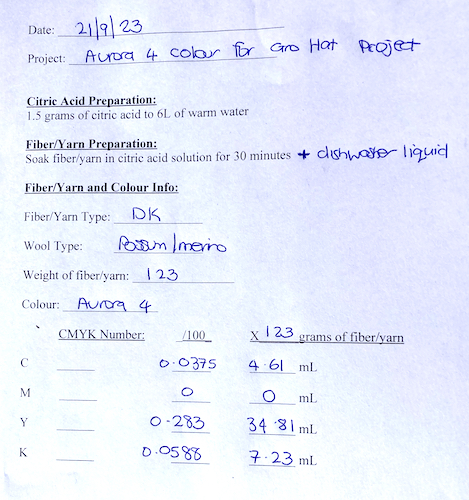
I've included in here my calculations for getting the aurora 4 colourway. When it comes to dyeing yarn, I used Ashford dyes, and mainly in the colours Teal, Hot Pink, Yellow, and Black, which are equal to Cyan, Magenta, Yellow, and Black. Combing these 4 colours can lead to an infinite number of colours. My Ashford dyes are made up as a 1% depth of shade (DOS) stock solution. For this project, I know the relative proportions of teal, yellow, and black I need to make the aurora 4 shade. I need to add 4.61 mL, 34.81 mL, and 7.23 mL of each respective dye stock solutions to dye 123 grams of possum merino yarn.
The first step in acid dyeing yarn is to make up the acid solution for dyeing. Ashford suggests to add white vinegar to make the water acidic, but it is horrible to work with when heated, and the fumes make my eyes water. So instead I have developed a system to use citric acid, which is easier to work with. To make up the citric acid water you add 1.5 grams of citric acid (which you can get from any supermarket) to 6L of water, and mix well. This is the solution you soak your yarn in, make up the DOS solutions, and also to dye in. To check the pH is at 4, I used a pH strip that I picked up from Trade Me.
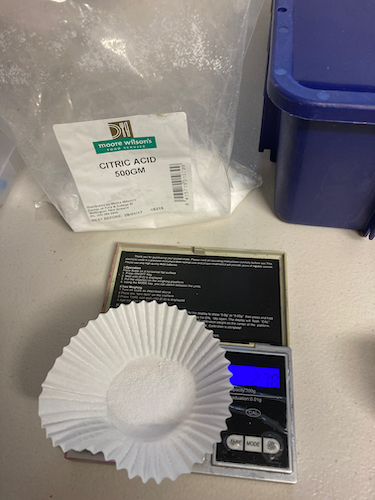
The next step in dyeing is to pre-soak the yarn. Into a container add some of the citric acid water and also a splash of unscented Ecostore Dishwashing Liquid, followed by the yarn you want to dye. The dish washing soap is in there to help open up the fibers so that the whole skein of yarn is wet through and ready for dyeing. I usually leave this to soak for 30 minutes.
When it came to getting out the acid dye stock solutions, I had previously run out of yellow stock solution, so I had to make up a new batch. To 198 grams of citric acid water I added 2 grams of Ashford yellow dye. I measure this out into a paper muffin cup on a small scale that I picked up on trade me. With this step is important to wear gloves and a mask (I used a N95 mask), not only to not dye my hands, but also to protect my lungs from the fine dye mist.
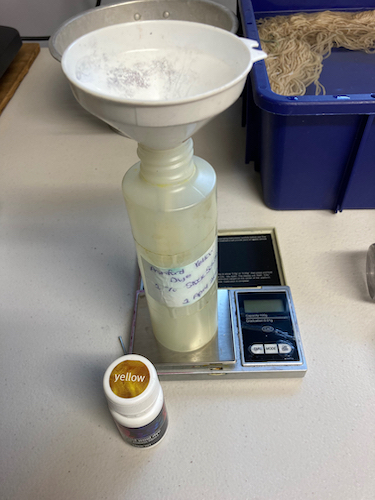
Once the yellow dye was well mixed, it was time to measure out the teal, yellow, and black stock solutions. After mixing each container well, I measured out each of the colours calculated above using plastic pipettes (which I also got from Trade Me) and the small scale and combined them. The aurora 4 colour was added to 6L of citric acid which was heating up in a stainless steel pot on the stove top, and mixed well. The yarn sitting in the solution was then wrung out and then added to the heating pot.
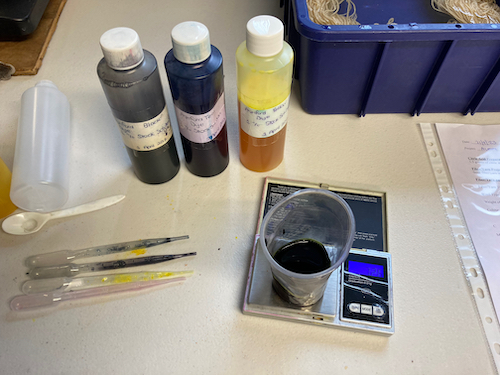
The yarn began to take up the dye straight away, and was gently mixed occasionally as the pot heated up to a simmer. The yarn and the pot was then left to simmer for 15 minutes. At the end of this time, the yarn had completely taken up the dye, and the citric acid water was clear when finished. The pot was turned off and left to cool.
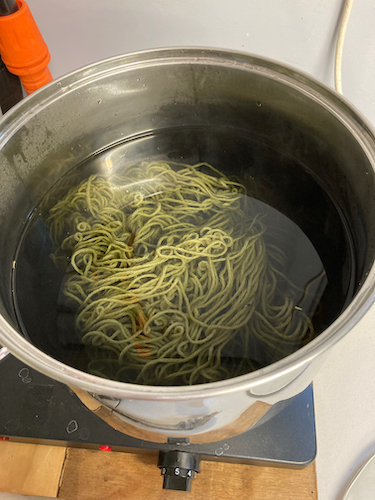
When the water had cooled, the yarn was removed from the pot. The citric acid water was left to cool to room temperature, and then baking soda was added to the water to return it to a pH of 7 (using a pH test strip), then discarded down the drain. The yarn was rinsed twice in luke warm water which had a little dish washer liquid added to it, not only to rinse out the citric acid water, but also to check that all the dye had indeed stuck permanently to the yarn. The yarn was then spun dry using the washing machine, and then left to dry outside.
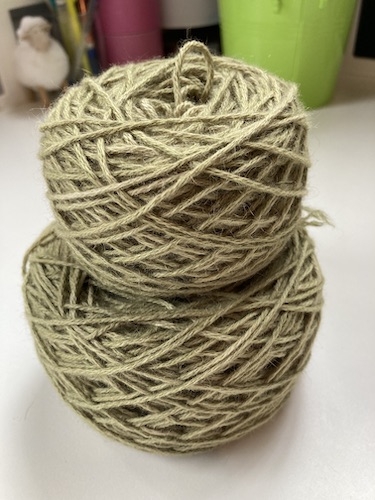
This is the finished yarn, and I'm really happy with it. I think because of the original colouring of the undyed yarn before dyeing, it's not quite the same as the sample yarn of the aurora 4 colour I have on file, but it's still close enough that I'm happy to start knitting with it.
Hopefully I'll have the hat knitted up over the coming spring and summer, so that it'll be ready to wear next autumn.
Have a wonderful day
Julie-Ann
Want to discuss my post? Feel free to chat with me on Instagram or Mastodon.




